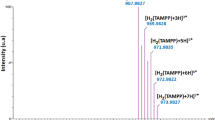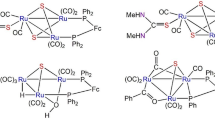Abstract
New Pd(II) complexes with 1-allyl-3-(2-pyridyl)thiourea (APTU) of the formulas [Pd(C9H11N3S)Cl2] (I) and [Pd(C9H11N3S)2]Cl2 (II) were obtained and examined by UV-Vis, IR, and 1H NMR spectroscopy. The conditions for the complexation reactions were optimized. The instability constants and molar absorption coefficients of these complexes were calculated. Comparison of the characteristic bands in the UV-Vis and IR spectra of the complexes and free APTU revealed that the ligand in both complexes is coordinated to the metal atom in the thione form in the bidentate chelating mode through the S atom of the thiourea group and the pyridine N atom. In the UV-Vis spectra of the complexes, the charge transfer bands (π → π* Py) and n → π* (C=NPy), (C=S) experience hypsochromic shifts by 450–470 cm−1 caused by the coordination of APTU to the metal ion, which gives rise to ligand-metal charge-transfer bands (C=NPy → Pd, n → π* (C=S)) and (SPd). The protons in the 6-, 4-, and 3-positions of the pyridine ring and the thiourea NH proton in the chelate ring are most sensitive to the complexation.
Similar content being viewed by others
References
W. Hernández, Ju. Paz, A. Vaisberg, et al., Bioinorg. Chem. Appl. Doi:10.1155/2008/690952.
J. Garcia-Tojal, A. Garcia-Orad, A. A. Diaz, et al., J. Inorg. Biochem. 84, 271 (2001).
Yu. L. Zborovskii, V. V. Orysyk, V. I. Staninets, et al., Zh. Org. Khim. 43(7), 1036 (2007).
L. A. Kazitsyna and N. B. Kupletskaya, Application of UV, IR, and NMR Spectroscopy in Inorganic Chemistry (Vysshaya Shkola, Moscow, 1971) [in Russian].
T. P. Stanojkovic, D. Kovala-Demertzi, A. Primikyri, et al., J. Inorg. Biochem. 104, 467 (2010).
A. Casti eiras, M. Gil, E. Bermejo, and D. X. West, Polyhedron 20, 449 (2001).
N. Bharti, S. S. Sharma, F. Naqvi, and A. Azam, Bioorg. Med. Chem. 11, 2923 (2003).
A. P. Rebolledo, M. Vieites, D. Gambino, et al., J. Inorg. Biochem. 99, 698 (2005).
A.P.B. Lever, Inorganic Electronic Spectroscopy, 2nd ed. (Elsevier, Amsterdam, 1984; Mir, Moscow, 1987).
V. V. Bon, S. I. Orysyk, V. I. Pekhnyo, et al., Polyhedron 26, 2935 (2007).
S. I. Orysyk, Ukr. Khim. Zh. 72(8), 65 (2008).
V. V. Bon’, S. Orisik, S. V. Pekhn’o, and V. V. Orisik, Ukraine Patent No. 23202, publ. 10.05.2007.
G. S. Borodkin, I. G. Borodkina, A. I. Uraev, et al., Ross. Khim. Zh. 58(1), 117 (2004).
M. I. Bulatov and I. P. Kalinkin, Practical Guide to Photometric Methods of Analysis (Khimiya, Leningrad, 1986) [in Russian].
S. Orysyk, V. Bon, and V. Pekhnyo, Acta Crystallogr., Sect. E 65, m1059 (2009).
Author information
Authors and Affiliations
Additional information
Original Russian Text © S.I. Orysyk, L.N. Rybachuk, V.I. Pekhnyo, V.V. Orysyk, 2011, published in Zhurnal Neorganicheskoi Khimii, 2011, Vol. 56, No. 11, pp. 1830–1834.
Rights and permissions
About this article
Cite this article
Orysyk, S.I., Rybachuk, L.N., Pekhnyo, V.I. et al. Palladium(II) complexes with 1-allyl-3-(2-pyridyl)thiourea: Synthesis and spectroscopic characterization. Russ. J. Inorg. Chem. 56, 1747–1751 (2011). https://doi.org/10.1134/S0036023611110222
Received:
Published:
Issue Date:
DOI: https://doi.org/10.1134/S0036023611110222




